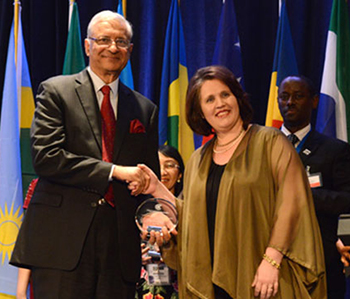Internet Broadcast Project grabs attention of Commonwealth – and yet another award

Learn more about the Internet Broadcast Project and its impact on learners’ lives
The Internet Broadcast Project (IBP) has brought yet another international award to the University of the Free State (UFS). This project – which is changing the lives of Free State school learners – has won second place in the Commonwealth Education Good Practice Awards, a huge achievement considering that the IBP was chosen from 89 submissions entered by a total of 20 countries belonging to the Commonwealth.
This latest award comes close on the heels of another international award that was presented to the IBP recently. In April 2015, the project was the winner of the 2015 Enterprise Video Award (EVA) in the category Video in Education Scholarship. This makes it two in a row, since the IBP also won an EVA in 2014 for Innovation in Pedagogy.

Mr Kamalesh Sharma, Secretary General of the Commonwealth Secretariat, presenting the second-place prize for the Commonwealth Good Practice Awards to Sarietjie Musgrave, Head: ICTISE (ICT in School Education) on behalf of ICTISE.
Photo: Peter Ramsay |
Live broadcast at no cost to schools
The IBP – presented from the UFS South Campus – makes use of the best teachers to broadcast lessons to school learners who do not have access to quality education. More than 10 subjects are broadcast live, via VSAT Internet Access, to 70 centres across the province. The technology provided at each school allows learners to communicate with the presenter in the studio during broadcast at no cost to the school or learner.
“Through the IBP,” says Sarietjie Musgrave, Head: ICTISE (ICT in School Education), “we aim to bring quality education to each and every learner, regardless of their socio-economic status or geographical location, while delivering cost-effective continuous teacher professional development directly relevant to the Free State community we serve.”
Making a positive difference
The Commonwealth Education Good Practice Awards honour education programmes that have made a positive difference to the status and condition of school children, teachers, or the education system in their countries. The IBP was lauded for its excellence in six of the Action Areas of Good Practices:
• Relevance
• Measurable impact and effect
• Sustainability
• Efficiency and effectiveness
• Community participation
• Replication
“Receiving this international award,” says Musgrave, “shows that we are having an impact worldwide.”